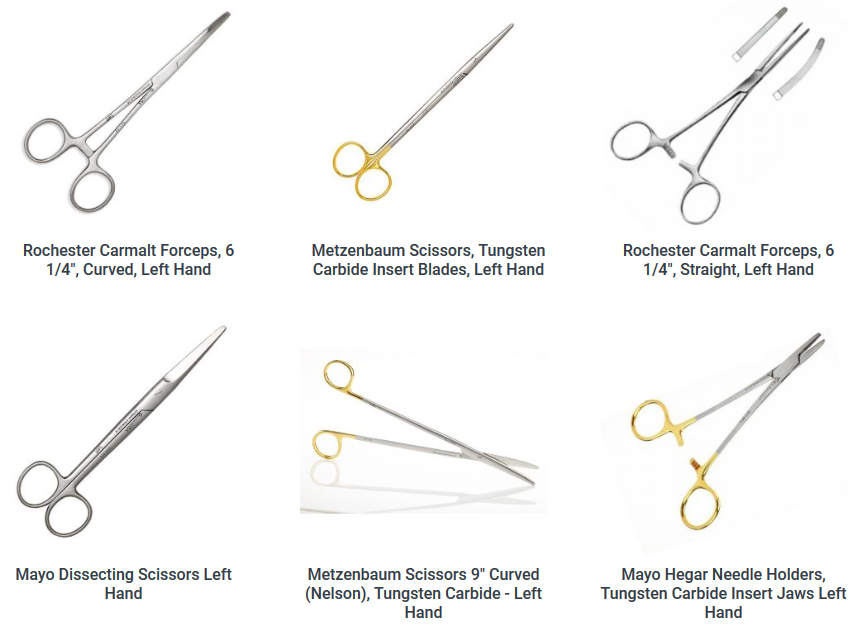Left-handed surgeons restrict exposure to left-handed equipment. During practicing, get no coaching in their left-handedness. And are more likely than their right-handed peers to have needles stick accidents. They also have great trouble in managing other devices.
Some of us belong to the approximate 10 percent left-handed group. And their fate might well have been very stressful. And unpleasant one earlier than though, bound to a stake at the same time. Fortunately, the issues of a left-handed person are far more ordinary now. If you're right-handed, you likely haven't even realized this, but it was pretty much all built for you.
Our company GerVetUSA stands among one of those pioneers who has created left-handed veterinary surgical instruments for veterinarians. Such as Bandage Scissors, Mayo dissecting Scissors, Metzenbaum Scissors, Mosquito Hemostatic Forceps, Olsen Hegar Needle Holders with Scissors, and Rochester Carmalt Forceps.
Let’s welcome to the left-handed surgeons
It needs to be noted that a wide level of accuracy and flexibility may be needed in surgery. Thus, need to that the surgeon is able to operate in an atmosphere that meets their needs. And has accessibility to the equipment they can utilize with convenience. Some scholars have addressed how left-handed surgeons can operate the opposite. And be equipped by right-handed ones with some training and adaptations. Firstly and the first thing they state is that interns do not try to use their right hand while they are right-handed. Yet, Left-Hand Instruments to allow left-handed surgeons the following acts:
· To be as accurate as right-hand people. Particularly when the outcomes are crucial in sensitive implementations;
• Human behavior to be used without a moment's hesitation.
• Easy to use tools, even movement.
• To check their equipment to the limit.
Preparing Set-up
We have tried to merge a list of tips after interviewing left-handed surgeon interns. For both left-handed and right-handed instructors. For instance, establishing a theater for a left-hand surgeon would be specific for a right-hander from that. For example, the care worker should be notified in anticipation. So that they can get the correct instruments and arrive ready to help. It is also important to inform the anesthetic staff because they need to make adjustments. When configuring as left-handed doctors need more elbow space. They continue to explain possible spreading strategies during surgery. cannulating the aorta, scraping ducts and even how better to get a patient off bypass.
Left-handed tools are seen as important. Sadly, they are usually not offered as usual in many medical facilities. And as a trainee, seeking the finances to buy them can be hard to make a petition. Especially as they are more costly than right-hand alternatives. Purchasing your own is a choice but costly of course.
Appropriate Use of Left Hand Instruments
To open the needle holder a right-hand doctor simply pushes their thumb through the above shaft. This leads to a change from the bottom handle of the details. That is independent of the ratchet connected to the upper handle. Afterward, the machine triggers and unlocks. Though, a similar pressing motion is now from the other side when the holder is put in the left hand. It moves the two skewers closer along with the teeth still fixed in position. So the left-handed surgeon will put their fingers in the gaps in the handles to draw it apart from two skewers. This motion doesn't feel as normal as the previous and is not regulated as quickly. Only with a left-hand needle holder, with the sharp teeth fixed in the reverse direction, would the left-handed surgeon be able to force the tool open with their thumbs in the same manner as their right-hand equivalents.
The device on the show is expected to be right-handed when supporting. For instance, devices used in assistance do not involve the exact skill level as needle holders. So instructors can learn how to operate them both with their right and left hand. While practicing with a left-hand surgeon alone is neither suggested nor realistic. It is helpful for a left-handed trainee to do so at some stages throughout their practice. Specifically when training how to use left-handed tools and methods.
Conclusion
Despite 90 percent of the world is right-handed, left-handed people are all too frequently left to adjust. To this the best they can to an environment that is clearly not built for them. But, there are times where it's important not to disregard left-handed person specifications. When a left-handed person wishes to become a surgeon, there is a range of hurdles to conquer. But with teamwork and a few changes, it is expected that they can find their practice at least no more difficult than their right-hand equivalents. Left-Hand Instruments play a vital role to perform any surgery. GerVetUSA has manufactured of the finest instruments for vets. After a quick review at our website, go grab yours.







